Abstract
1. The ability of atipamezole, a specific and selective alpha 2-adrenoceptor antagonist, to reverse the pharmacological effects induced by the alpha 2-adrenoceptor agonist dexmedetomidine was studied in six healthy male volunteers. Each volunteer received in four sessions in a randomized and single-blind manner three different doses (6.7 micrograms kg-1, 27 micrograms kg-1 and 67 micrograms kg-1) of atipamezole or saline placebo as 5 min i.v. infusions preceded by a fixed i.v. dose of dexmedetomidine (0.67 micrograms kg-1). 2. Dexmedetomidine caused profound sedation, with the subjects actually falling asleep. This was effectively reversed by the two highest doses of antipamezole. 3. Dexmedetomidine reduced salivary flow on average by 70%. A rapid and full reversal of this effect was seen after the highest dose of antipamezole. 4. Hypotension induced by dexmedetomidine was also effectively antagonized by atipamezole. Bradycardia was very modest after dexmedetomidine in this study, and thus no reversal of alpha 2-adrenoceptor agonist-induced bradycardia could be demonstrated. 5. Plasma noradrenaline concentrations were reduced by 80% by dexmedetomidine. This was effectively antagonized by atipamezole, and the highest dose caused a 50% overshoot in plasma noradrenaline concentrations over the basal levels. 6. It is concluded that the effects of dexmedetomidine are effectively reversible by atipamezole. A dose ratio of 10:1 for atipamezole:dexmedetomidine was clearly insufficient for this purpose, but ratios in the range of 40:1 to 100:1 were found to be effective in the current experimental situation.
Full text
PDF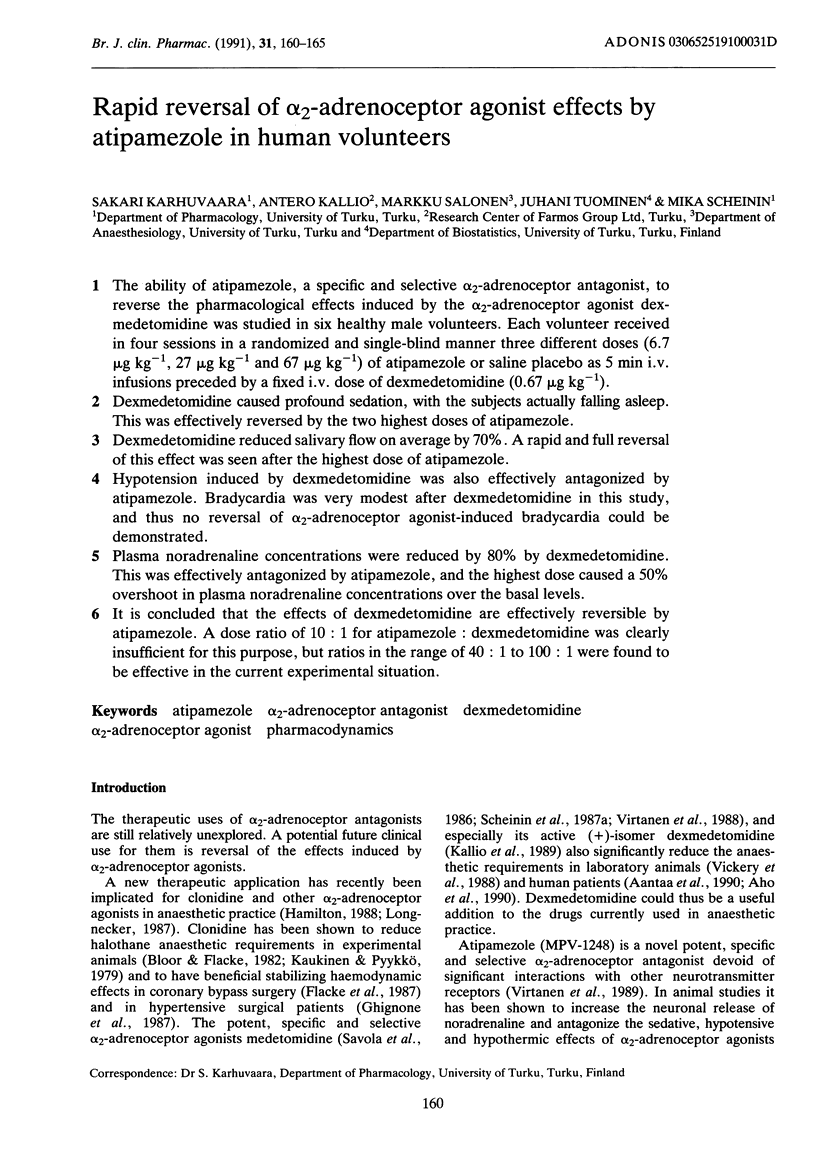

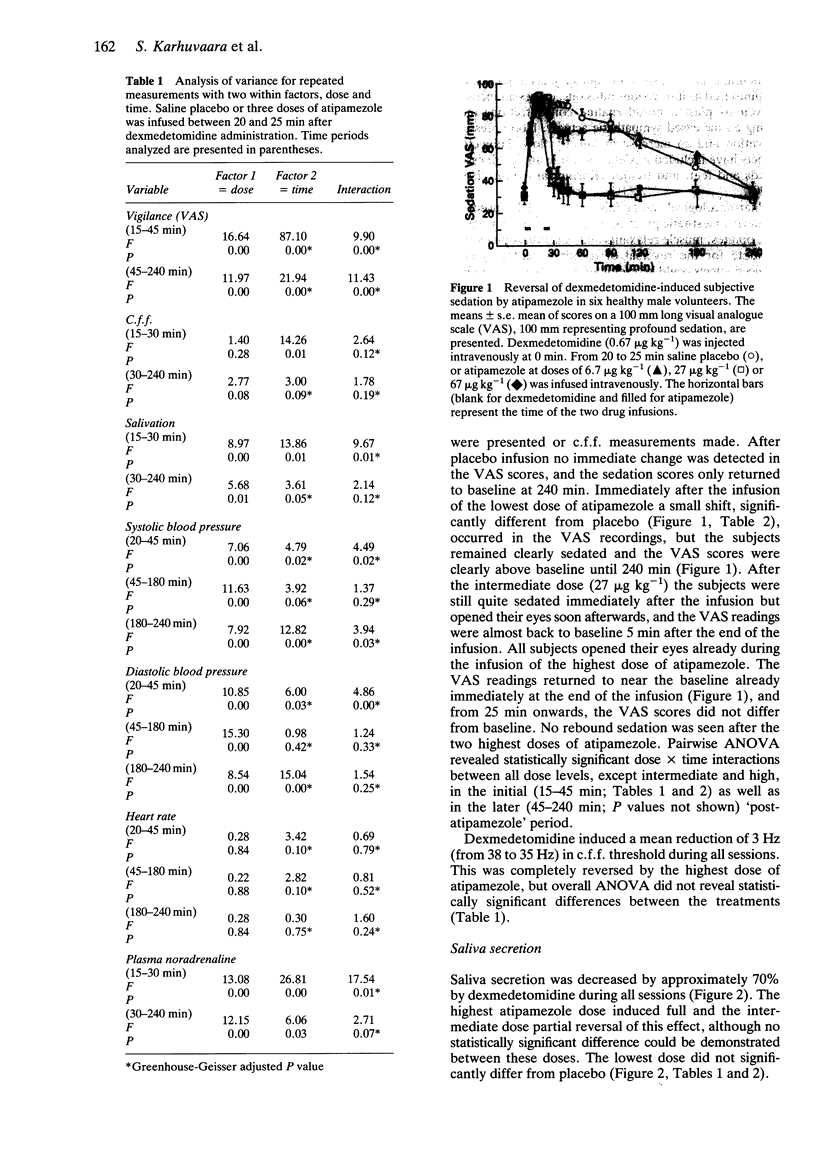
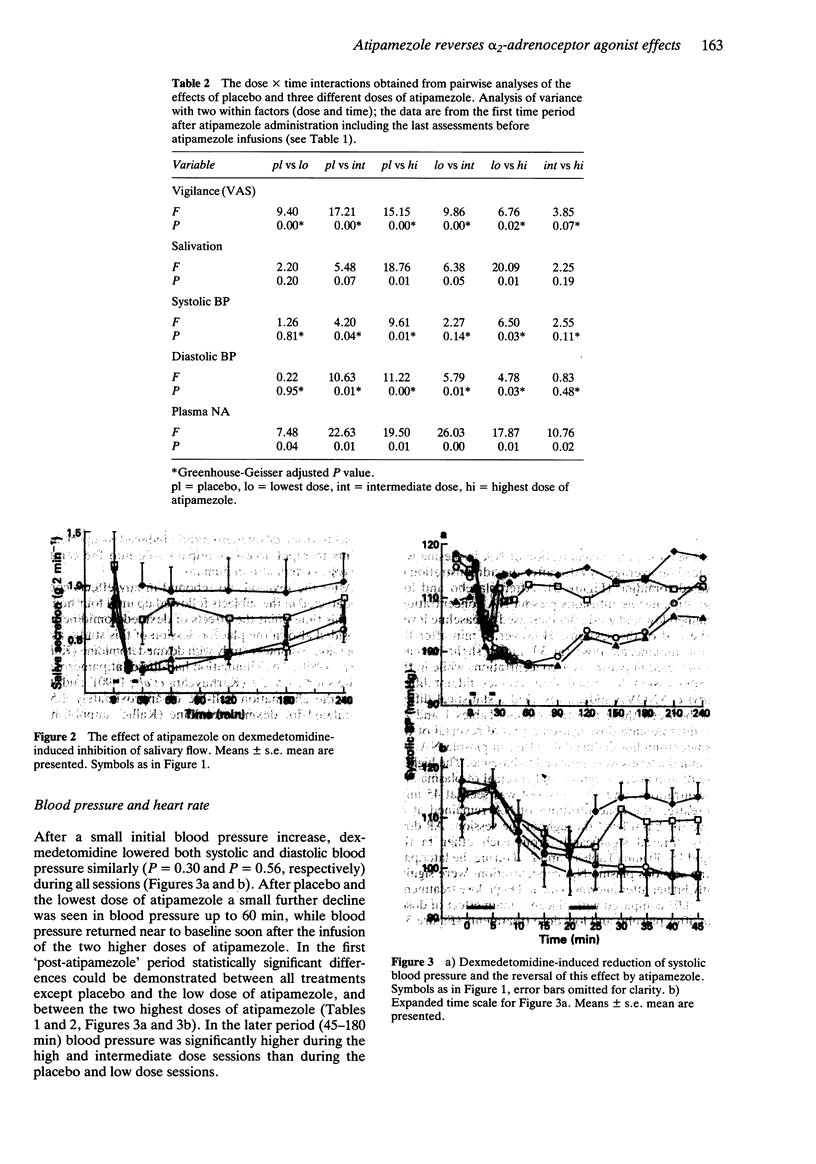
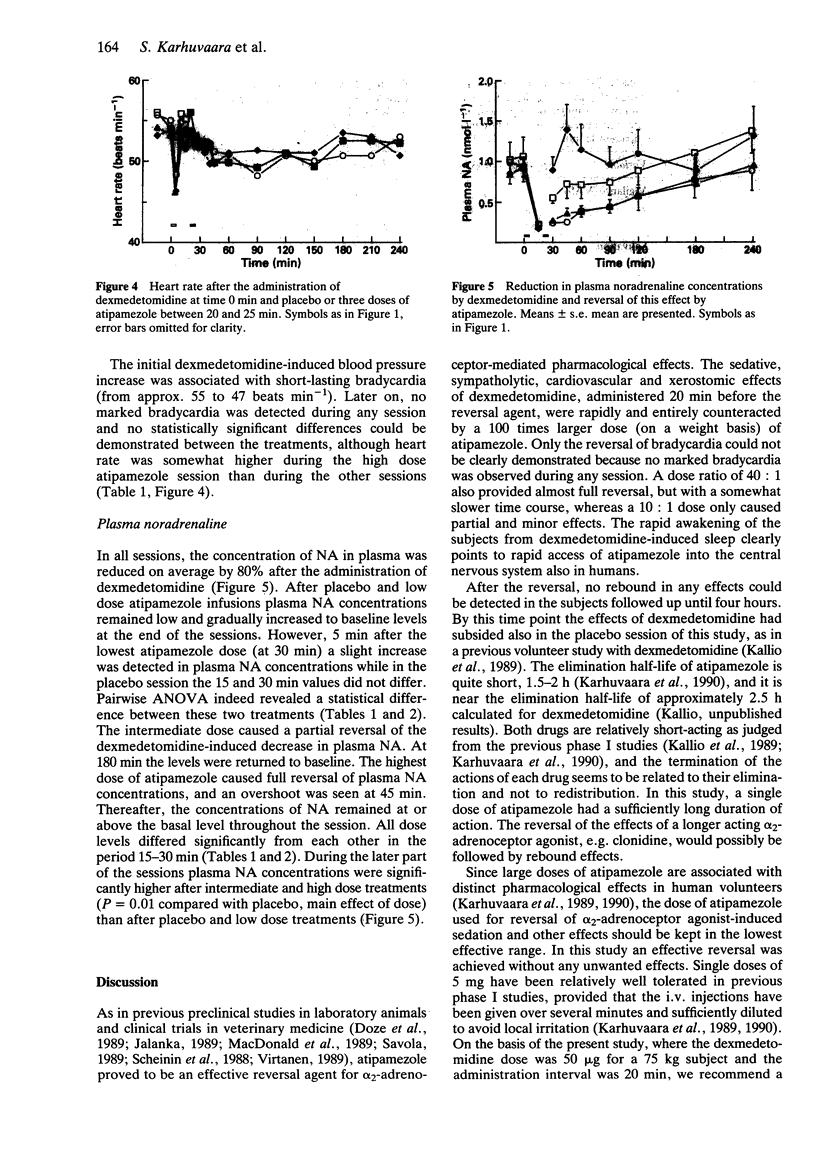
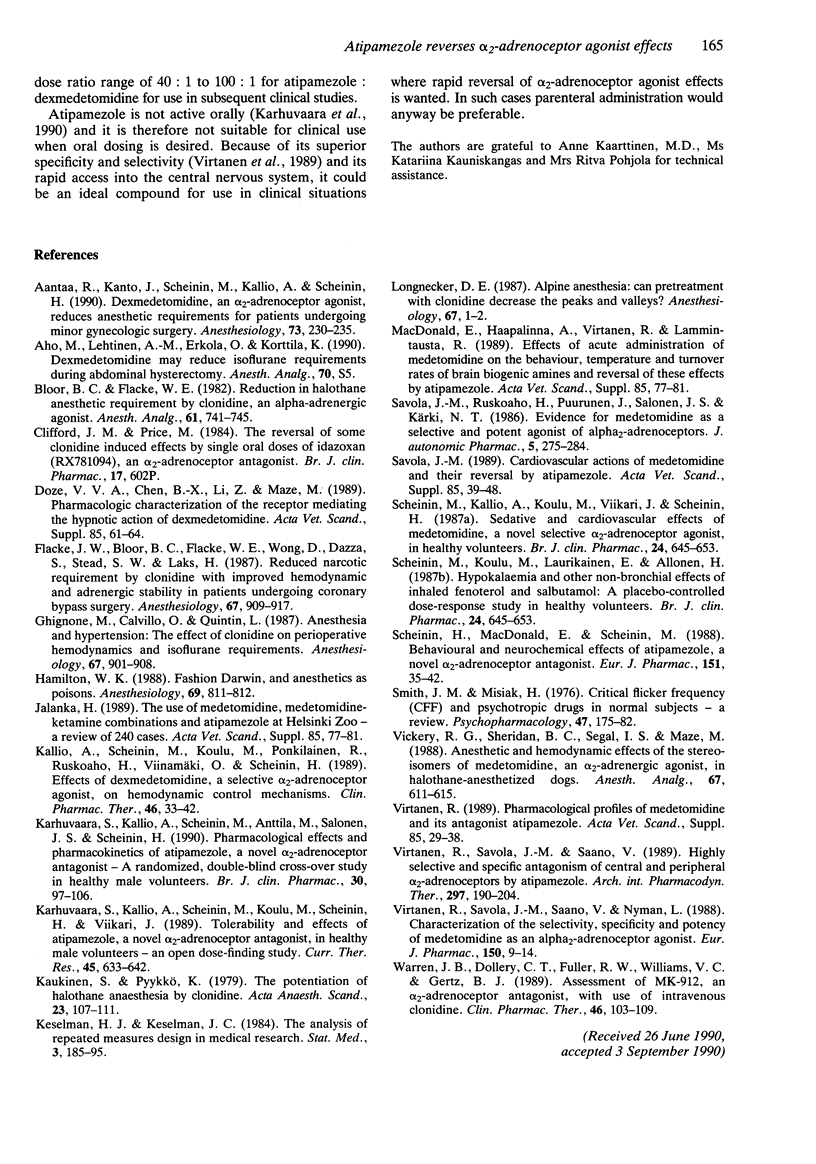
Selected References
These references are in PubMed. This may not be the complete list of references from this article.
- Aantaa R., Kanto J., Scheinin M., Kallio A., Scheinin H. Dexmedetomidine, an alpha 2-adrenoceptor agonist, reduces anesthetic requirements for patients undergoing minor gynecologic surgery. Anesthesiology. 1990 Aug;73(2):230–235. doi: 10.1097/00000542-199008000-00007. [DOI] [PubMed] [Google Scholar]
- Bloor B. C., Flacke W. E. Reduction in halothane anesthetic requirement by clonidine, an alpha-adrenergic agonist. Anesth Analg. 1982 Sep;61(9):741–745. [PubMed] [Google Scholar]
- Doze V., Chen B. X., Li Z., Maze M. Pharmacologic characterization of the receptor mediating the hypnotic action of dexmedetomidine. Acta Vet Scand Suppl. 1989;85:61–64. [PubMed] [Google Scholar]
- Hamilton W. K. Fashion, Darwin, and anesthetics as poisons. Anesthesiology. 1988 Dec;69(6):811–812. doi: 10.1097/00000542-198812000-00001. [DOI] [PubMed] [Google Scholar]
- Kallio A., Scheinin M., Koulu M., Ponkilainen R., Ruskoaho H., Viinamäki O., Scheinin H. Effects of dexmedetomidine, a selective alpha 2-adrenoceptor agonist, on hemodynamic control mechanisms. Clin Pharmacol Ther. 1989 Jul;46(1):33–42. doi: 10.1038/clpt.1989.103. [DOI] [PubMed] [Google Scholar]
- Karhuvaara S., Kallio A., Scheinin M., Anttila M., Salonen J. S., Scheinin H. Pharmacological effects and pharmacokinetics of atipamezole, a novel alpha 2-adrenoceptor antagonist--a randomized, double-blind cross-over study in healthy male volunteers. Br J Clin Pharmacol. 1990 Jul;30(1):97–106. doi: 10.1111/j.1365-2125.1990.tb03748.x. [DOI] [PMC free article] [PubMed] [Google Scholar]
- Kaukinen S., Pyykkö K. The potentiation of halothane anaesthesia by clonidine. Acta Anaesthesiol Scand. 1979 Feb;23(1):107–111. doi: 10.1111/j.1399-6576.1979.tb01429.x. [DOI] [PubMed] [Google Scholar]
- Keselman H. J., Keselman J. C. The analysis of repeated measures designs in medical research. Stat Med. 1984 Apr-Jun;3(2):185–195. doi: 10.1002/sim.4780030211. [DOI] [PubMed] [Google Scholar]
- Longnecker D. E. Alpine anesthesia: can pretreatment with clonidine decrease the peaks and valleys? Anesthesiology. 1987 Jul;67(1):1–2. [PubMed] [Google Scholar]
- MacDonald E., Haapalinna A., Virtanen R., Lammintausta R. Effects of acute administration of medetomidine on the behaviour, temperature and turnover rates of brain biogenic amines in rodents and reversal of these effects by atipamezole. Acta Vet Scand Suppl. 1989;85:77–81. [PubMed] [Google Scholar]
- Savola J. M., Ruskoaho H., Puurunen J., Salonen J. S., Kärki N. T. Evidence for medetomidine as a selective and potent agonist at alpha 2-adrenoreceptors. J Auton Pharmacol. 1986 Dec;6(4):275–284. doi: 10.1111/j.1474-8673.1986.tb00654.x. [DOI] [PubMed] [Google Scholar]
- Scheinin H., MacDonald E., Scheinin M. Behavioural and neurochemical effects of antipamezole, a novel alpha 2-adrenoceptor antagonist. Eur J Pharmacol. 1988 Jun 22;151(1):35–42. doi: 10.1016/0014-2999(88)90689-9. [DOI] [PubMed] [Google Scholar]
- Scheinin M., Koulu M., Laurikainen E., Allonen H. Hypokalaemia and other non-bronchial effects of inhaled fenoterol and salbutamol: a placebo-controlled dose-response study in healthy volunteers. Br J Clin Pharmacol. 1987 Nov;24(5):645–653. doi: 10.1111/j.1365-2125.1987.tb03224.x. [DOI] [PMC free article] [PubMed] [Google Scholar]
- Scheinin M., Koulu M., Laurikainen E., Allonen H. Hypokalaemia and other non-bronchial effects of inhaled fenoterol and salbutamol: a placebo-controlled dose-response study in healthy volunteers. Br J Clin Pharmacol. 1987 Nov;24(5):645–653. doi: 10.1111/j.1365-2125.1987.tb03224.x. [DOI] [PMC free article] [PubMed] [Google Scholar]
- Smith J. M., Misiak H. Critical flicker frequency (CFF) and psychotropic drugs in normal human subjects-a review. Psychopharmacologia. 1976 May 28;47(2):175–182. doi: 10.1007/BF00735818. [DOI] [PubMed] [Google Scholar]
- Vickery R. G., Sheridan B. C., Segal I. S., Maze M. Anesthetic and hemodynamic effects of the stereoisomers of medetomidine, an alpha 2-adrenergic agonist, in halothane-anesthetized dogs. Anesth Analg. 1988 Jul;67(7):611–615. [PubMed] [Google Scholar]
- Virtanen R., Savola J. M., Saano V. Highly selective and specific antagonism of central and peripheral alpha 2-adrenoceptors by atipamezole. Arch Int Pharmacodyn Ther. 1989 Jan-Feb;297:190–204. [PubMed] [Google Scholar]
- Virtanen R., Savola J. M., Saano V., Nyman L. Characterization of the selectivity, specificity and potency of medetomidine as an alpha 2-adrenoceptor agonist. Eur J Pharmacol. 1988 May 20;150(1-2):9–14. doi: 10.1016/0014-2999(88)90744-3. [DOI] [PubMed] [Google Scholar]
- Warren J. B., Dollery C. T., Fuller R. W., Williams V. C., Gertz B. J. Assessment of MK-912, an alpha 2-adrenoceptor antagonist, with use of intravenous clonidine. Clin Pharmacol Ther. 1989 Jul;46(1):103–109. doi: 10.1038/clpt.1989.113. [DOI] [PubMed] [Google Scholar]


